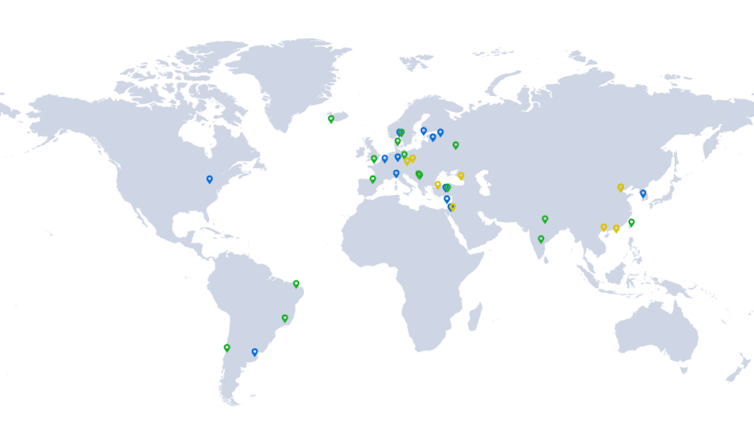Source: The Conversation – (in Spanish) – By Joan Tahull Fort, Profesor e investigador en sociología, especializado en dinámicas sociales y educativas contemporáneas, Universitat de Lleida

En España, la sequía condiciona la vida de más de 700 000 personas. Mientras en algunas ciudades el agua sale con naturalidad en las fuentes públicas, en otros territorios el caudal se ve a veces restringido por la escasez. Estas cifras no solo hablan de una crisis hídrica, sino también de una crisis social: el agua se ha convertido en un recurso en disputa y en un indicador de desigualdad.
El agua ha acompañado a la humanidad desde sus orígenes. No solo es indispensable para la vida, también ha sido y (sigue siendo) una fuente de significados culturales, espirituales y emocionales. A lo largo de la historia y en diversas culturas, el agua se ha vinculado con la fertilidad, la calma, la renovación o la trascendencia. Muchos mitos de creación sitúan el agua como el principio del mundo, del mismo modo que numerosos rituales de purificación la emplean como medio para recomenzar y limpiar.
Ríos, lagos, mares y manantiales han sido a lo largo de la historia escenarios privilegiados de contemplación y recogimiento. Espacios para tomar distancia del ruido cotidiano y reencontrarse con lo esencial.
Hoy, en pleno contexto de crisis climática, con sequías prolongadas, olas de calor extremo y episodios de contaminación que afectan directamente a ríos y costas, esta relación con el agua adquiere una relevancia nueva y urgente. El agua es un recurso en disputa y un reflejo de nuestra vulnerabilidad como sociedad.
El agua en la vida contemporánea
En pleno siglo XXI, esa relación persiste, aunque bajo nuevas formas. El agua aparece en la vida urbana y cotidiana de maneras diversas: quien corre junto a un río busca tanto ejercicio como introspección. Haruki Murakami dice literalmente en su libro De qué hablo cuando hablo de correr, en referencia al río Charles (Boston, Estados Unidos): “La gente se reúne en la ribera de este río como atraída por un imán”. Quien se sienta frente al mar encuentra un espacio para meditar; incluso el sonido de una fuente en la ciudad ofrece un respiro, una pausa en medio de la prisa.
Estudios recientes sobre “blue spaces” (espacios azules) han mostrado que el contacto regular con entornos relacionados con el agua (incluso en ciudades) reduce el estrés, mejora el ánimo e incluso contribuye a la recuperación psicológica tras periodos de enfermedad, estrés, soledad, duelo… El agua proporciona descanso, bienestar y una manera de reconectar con uno mismo y con el entorno.
Lugar de encuentro y socialización
La relación del ser humano con el agua va mucho más allá de lo material. Además de sostener la vida, el agua organiza la convivencia: genera vínculos, articula encuentros y ofrece marcos comunes para celebrar, recordar o simplemente estar juntos.
Las orillas de ríos, lagos y mares han sido, históricamente, espacios donde las comunidades se reconocen y socializan. En las ciudades, el agua conserva ese papel de articuladora social: una fuente invita a detenerse, un estanque en el parque se convierte en escenario de juegos infantiles, y las riberas de un río urbano atraen tanto a quienes buscan calma como a quienes practican deporte. En los entornos rurales, lagos, embalses y manantiales mantienen la vida comunitaria, acogen fiestas, reuniones vecinales y refuerzan la identidad local.
Las playas, por su parte, representan el ejemplo más universal de este carácter compartido: millones de personas coinciden cada verano en torno al mismo escenario, compartiendo experiencias. Allí, lo privado y lo público se entrelazan en un mismo espacio, lo que convierte al litoral en un punto de encuentro masivo.
Así, el agua no es solo parte del paisaje: es un elemento social clave. Marca ritmos (temporadas, horarios y usos), multiplica las oportunidades de encuentro y aporta identidad cultural. Del ocio al deporte, de la contemplación a las celebraciones multitudinarias; el agua sigue siendo un bien común donde se construyen las comunidades y se transmiten experiencias.
Leer más:
Los espacios verdes urbanos promueven una ciudadanía más sostenible, conectada e igualitaria
Agua y sociedad en el siglo XXI
En un mundo acelerado, hiperconectado y dominado por pantallas, el agua ofrece lo contrario: invita a la pausa, al ritmo lento, a la contemplación y al encuentro. Nos recuerda tanto nuestra vulnerabilidad frente a la escasez como nuestra capacidad de resiliencia y de hallar un equilibrio.
Cada vez más se habla de una “nueva cultura del agua”, un cambio de paradigma: del agua entendida como un recurso meramente productivo a un bien común, cuya gestión requiere enfoques ecosistémicos, participación ciudadana y principios de equidad social.
Este enfoque amplía la mirada con las siguientes perspectivas:
-
Acceso justo y seguro a espacios acuáticos de calidad. No se trata solo de regular consumos o caudales: el acceso cotidiano a riberas, playas, canales y fuentes actúa como determinante social de la salud.
-
Protección ecológica con reconocimiento del valor cultural y social de las orillas. Salvaguardar ríos, lagos y costas no es solo conservación biológica; es también salud pública, cohesión e identidad.
-
Del recurso al derecho. El agua no es únicamente naturaleza: estructura la vida comunitaria y está reconocida como derecho humano (agua potable y saneamiento), lo que implica obligaciones de no discriminación, asequibilidad y accesibilidad.
Desde esta perspectiva, diseñar ciudades con riberas accesibles, fuentes habitables o playas urbanas seguras deja de ser un lujo para convertirse en una política pública de salud y bienestar.
Este debate también plantea una pregunta clave sobre planificación urbana y justicia ambiental: ¿quién tiene acceso a los espacios acuáticos y quién queda excluido? En muchas ciudades, las zonas ribereñas se privatizan o transforman en espacios de consumo, limitando su función como bienes comunes. Incorporar esta dimensión permite entender el agua no solo como recurso natural, sino como derecho colectivo.
Leer más:
El acceso a los parques, ¿también al alcance de las personas mayores?
Preservar un bien común
Cerca del agua se desarrollan nuestras experiencias colectivas: descansar, encontrarnos, estar con nosotros mismos y con los demás…
En tiempos de incertidumbre, el agua nos devuelve a lo esencial: el bienestar no se construye de manera aislada, sino en espacios compartidos. Por eso, cuidar las orillas (urbanas o rurales, marinas o fluviales) no es solo un gesto medioambiental: es preservar uno de los últimos bienes comunes capaces de sostener nuestra vida social, cultural y emocional.
El futuro de nuestra relación con el agua no está solo en las políticas de gestión o en las infraestructuras hidráulicas, sino en la capacidad de reconocerla como un bien común y como un vínculo social, cultural y emocional que nos une. En su cuidado está no solo la salud de los ecosistemas, sino también el bienestar y la cohesión de nuestras sociedades.
![]()
Joan Tahull Fort no recibe salario, ni ejerce labores de consultoría, ni posee acciones, ni recibe financiación de ninguna compañía u organización que pueda obtener beneficio de este artículo, y ha declarado carecer de vínculos relevantes más allá del cargo académico citado.
– ref. El agua que nos une – https://theconversation.com/el-agua-que-nos-une-264850















